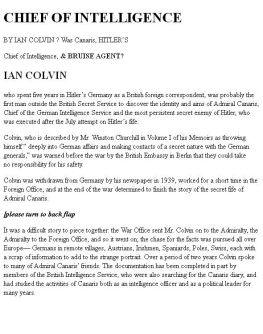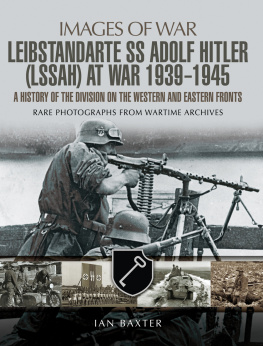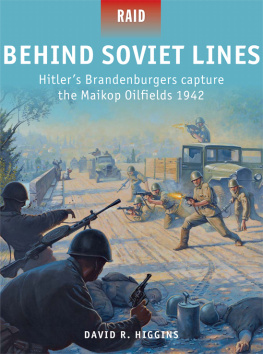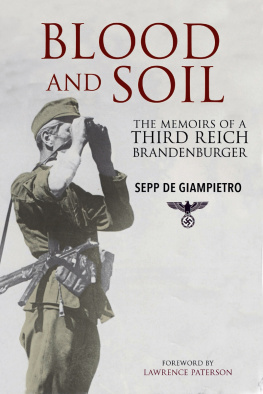HITLERS BRANDENBURGERS
Brandenburger troops searching for Greek guerrillas in the Balkans in 1944
HITLERS BRANDENBURGERS
The Third Reichs Elite Special Forces
Lawrence Paterson
Foreword by David R. Higgins
Hitlers Brandenburgers: The Third Reichs Elite Special Forces

Greenhill Books, c/o Pen & Sword Books Ltd, 47 Church Street, Barnsley, S. Yorkshire, S70 2AS
For more information on our books, please visit
or write to us at the above address.
Published and distributed in the United States of America and Canada by the Naval Institute Press, 291 Wood Road, Annapolis, Maryland 21402-5043
www.nip.org
Text copyright Lawrence Paterson, 2018
Foreword copyright David R. Higgins, 2018
The right of Lawrence Paterson to be identified as the author of this work has been asserted in accordance with Section 77 of the Copyrights Designs and Patents Act 1988.
CIP data records for this title are available from the British Library Library of Congress Cataloging Number: 2018932808
Greenhill Books ISBN 978-1-78438-228-5
Naval Institute Press ISBN 978-1-68247-372-6
eISBN 978-1-78438-230-8
Mobi ISBN 978-1-78438-229-2
Contents
Plates
1 Kampforganisation Jablunka photographed before the attack on Poland2A second photo taken at the same time3Theodor von Hippel4Officers of the Deutsche Kompanie in their Slovakian base at Slia, August 19395 Hauptmann Hans-Jrgen Rudloff inspecting his men of the 3rd Baulehr Kompanie z.b.V. 800 6A bridge over the Juliana Canal, captured by Leutnant Hermann Krschners West Platoon7The Gennep railway bridge after its capture by Oberleutnant Uwe-Wilhelm Walthers 4th Baulehr Kompanie z.b.V. 800 8The Nieuport bridge after its capture by Leutnant Siegfried Graberts assault group on the night of 27 May 19409Graberts original drawing of the new regiments insignia10Siegfried Grabert11Deputy Fhrer Rudolf Hess greeting Knights Cross holders12Not all bridges were captured intact; this one over the Drava River was successfully destroyed by retreating Yugoslavian troops, 194113Uwe-Wilhelm Walther14The raising of the flag over the Acropolis in Athens by Brandenburgers15 Oberstleutnant Paul Haehling von Lanzenauer and Major Friedrich Wilhelm Heinz16Ukrainian troops of the Nachtigall Battalion in training at Neuhammer17A destroyed Brandenburger vehicle next to a disabled Soviet BT7 light tank18Brandenburger troops in Soviet uniform during the opening day of Operation Barbarossa 19The sheer volume of Soviet prisoners taken during Barbarossa was staggering20 Feldwebel Willi Hein and Leutnant Oskar Schatz in full Soviet disguise21Casualties within the regiment were relatively heavy22A Fallschirmjger wearing an early pattern army belt buckle23The grave Leutnant Hermann Ltke and his fellow Fallschirmjger 24 Oberleutnant Hans-Wolfram Knaak25The grave of Knaak and four of his men26Nachtigall troops on the streets of Lviv at the end of June27Checking a dusty Russian road for mines28An officer of the Azad Hid Fauj (Free India Army) at Regenwurmlager 29The Free India Army was raised in Germany and trained as part of the Brandenburgers30Friedrich Fritz von Koenen31Brandenburgers of the 13th Company using captured Allied vehicles32 Rittmeister Conrad von Leipzig33Brandenburger troops in North Africa34An LWSI of the Tropical Company during rehearsals with Kampfgruppe Hecker 35Tobruk finally fell to Rommels forces in June 194236 Hauptmann Count Lszl Almsy and Major Nikolaus Ritter37Ritter and Almsy brief Luftwaffe pilots for the disastrous flight into Egypt during June 194138Brandenburger troops returning to German lines39Odo Wilscher40Light vehicle of the 13th (Tropical) Company, equipped with a single 20mm flak cannon41Car emblazoned with the emblem of Sonderkommando Blaich 42A soldier of the Free Arabia Legion43Brandenburger recruits for the Kustenjger Abteilung 44Identity card of a Soviet prisoner of war recruited into the Brandenburger Regiment45 Admiral Wilhelm Canaris on a visit to Brandenburg units at the front lines in Russian, October 194146 Leutnant Trommsdorf and Finnish troops47Brandenburgers kayaking towards the Murmansk railway line, August 194248Adjusting the small outboard motor aboard one of the Brandenburgers kayaks49Brandenburgers in Finland used a mixture of German, Soviet and Finnish uniform and equipment50 Fritz Babuke51 Chief instructor Leutnant zur See Alfred von Wurzian and Gebirgsjger Hauptmann Fritz Neitzert (middle) was the Abteilungs first commander52The Brandenburger Meeresjger Abteilung on parade in Piazza Dante, Valdagno, 194453Case Blue, the advance into the Caucasus in pursuit of oil, spearheaded by Brandenburger units54Alexander von Pfuhlstein with Generalmajor Karl von Graffen55 Admiral Canaris inspecting Brandenburger troops with Friedrich Wilhelm Heinz and Alexander von Pfuhlstein56An NCO briefing during the advance of Case Blue57Cooperation between Brandenburg and Romanian forces had begun before the invasion of the Soviet Union58Siegfried Graberts death in action announced in the newspaper Die Bewegung 59Adrian Baron von Flkersam60Fighting for the oil transport depots in the Caucasus, 194261The bridge over the Bjelaja named after Leutnant d.R. Ernst Prochaska62 Oberleutnant Karl-Heinz Oesterwitz63Kurt Konrad Steidl64The huge stone eagle that guarded the entrance gate to the Regenwurm training camp65Personnel in training at Regenwurmlager 66The brutality of antipartisan warfare became an increasingly common theatre of action for the Brandenburgers67Brandenburgers were used in the inhospitable forests and marshes that surrounded the Pripyat River to fight Soviet partisans in 194468 Jger of the Brandenburger Division receiving fresh winter clothing69Men of the Kustenjger Abteilung at sea on the Adriatic aboard a heavy Sturmboot 70 Leutnant Helmut Demetrio and his French men of the 8th Company, II Battalion71An Italian soldier of the Blackshirt III M Assault Battalion 9 September (Pontida)72Brandenburger troops were committed to searching for and fighting Greek guerrillas73Brandenburgers and Chetniks, uneasy allies of convenience most of the time74Brandenburgers question captured Yugoslavian Partisans75Well armed, disciplined and well organised, the communist Partisans that followed Marshal Josip Broz Tito were formidable adversaries76Brandenburgers in action in Yugoslavia, 194377Brandenburger Fallschirmjger rowing ashore on Levitha78Brandenburger troops during the fighting for Leros, November 194379Troops of the 1st Company, Kustenjger Abteilung on Monte Racchi, Leros80Relaxing once the fighting had ended on Leros81Brandenburgers displaying an interesting mix of uniforms, Leros, 194382Wilhelm Walther with Oberleutnant Max Wandrey and General der Flieger Helmuth Felmy83Brandenburger troops boarding a Marinefahrprhme in the Dodecanese, 194384 Oberleutnant Werner Lau, II Battalion, 4th Regiment Brandenburg85 Major Karl-Heinz Oesterwitz86Friedrich Fritz Khlwein87Brandenburger PaK40 of the 2nd Regiment in action against Yugoslavian Partisans88Otto Skorzeny in Budapest, 194489Dawn on the Eastern Front.90The Brandenburg cuff title
Photos : U-Boot Archiv, Altenbruch All other photos: Bundesarchiv
Foreword by David R. Higgins
For all the attention production numbers, vehicle firepower and tactics receive as factors in achieving battlefield success, such results were often contingent on the covert, unconventional actions of small teams of specially selected, highly-trained and motivated, and largely unsung warriors. Whatever quality of arms and quantity of material a modern army possesses, its reliance on a host of arguably unglamorous necessities such as logistics and manufacturing, or less tangible assets like security, morale and sleep to function effectively can become targeted as a vulnerability or liability. For all the effort allocated to protecting these valuable resources and services, the need for human beings in the mix, with all their insecurities, fears, greed, obedience to authority, and a host of other potentially exploitable attributes, can represent a militarys greatest weakness given the right circumstances and psychological incentives. With the right combination of leadership, planning, audacity, creativity and cunning, a determined adversary conducting effective covert missions involving long-range reconnaissance, sabotage, assassination, propaganda, infiltration and other similar tasks can cumulatively disrupt an enemys ability to sustain itself in the field, impede its command and control, and undermine resolve. If implemented correctly, such behind-the-lines actions can produce decisive outcomes out of all proportion to initial expenditures.
Next page











